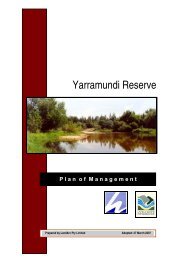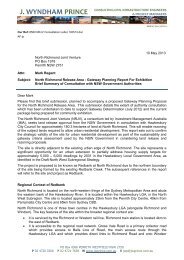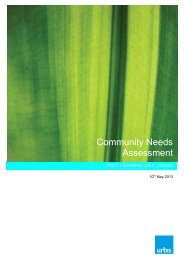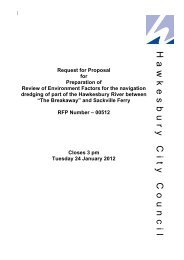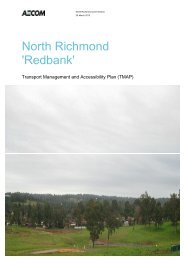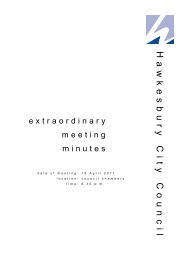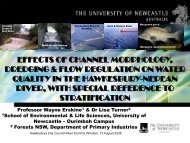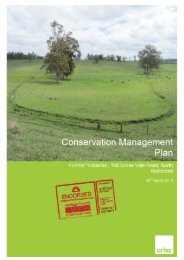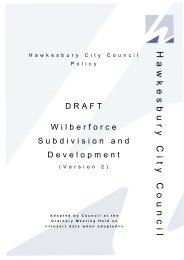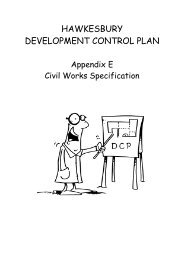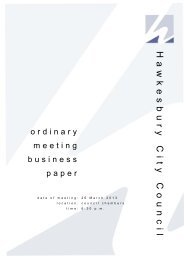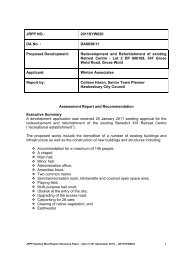Attachment 1 to Item 53 - Roadside Vegetation Management Plan
Attachment 1 to Item 53 - Roadside Vegetation Management Plan
Attachment 1 to Item 53 - Roadside Vegetation Management Plan
Create successful ePaper yourself
Turn your PDF publications into a flip-book with our unique Google optimized e-Paper software.
H AW K E S B U R Y C IT Y C O U N C IL R O AD S ID E V E G E T AT IO N M AN AG E M E N T P L AN<br />
o surplus material that cannot be recycled in<strong>to</strong> the road pavement or shoulder should<br />
be placed in an appropriate location away from drainage lines and removed <strong>to</strong><br />
another maintenance site;<br />
o ensure that continued grading over time does not cause the road profile <strong>to</strong> become<br />
entrenched below the general level of the surrounding land, thereby creating a<br />
drainage channel. This eventuality needs <strong>to</strong> be corrected as it will increase flow<br />
volumes at drainage lines and can cause localised flooding, both potential<br />
contribu<strong>to</strong>rs <strong>to</strong> soil erosion;<br />
o apply erosion and sediment controls such as sediment fencing, if works are within 20<br />
metres of a waterway, or rainy conditions are expected;<br />
o compact the work area immediately after grading. If moisture content is <strong>to</strong>o low,<br />
apply water or postpone grading until rainfall occurs;<br />
o protect tree trunks and avoid knocking bark off the base of trees with the grader<br />
blade. Damage <strong>to</strong> the tree trunk can result in disease or decay entering the tree<br />
trunk;<br />
o avoid excavating or piling soil material within tree drip lines;<br />
o avoid pushing loose soil up in<strong>to</strong> native vegetation on the roadside as this<br />
encourages weed invasion;<br />
o turn grading machines only at road intersections, landholder driveways or within the<br />
road envelope; and<br />
o undertake hygiene practices (eg. for the control of Phy<strong>to</strong>phthora) when a new<br />
section of road is graded.<br />
6.4 ENDANGERED ECOLOGICAL COMMUNITIES AND THREATENED FLORA AND<br />
FAUNA SPECIES<br />
As identified in Section 3.3 and 3.4, a number of EECs and threatened flora and fauna species have<br />
been previously recorded on HCC’s rural roads. Further, Acacia pubescens (Downy Wattle), Grevillea<br />
juniperina spp. juniperina and Persoonia hirsuta ssp. hirsuta (Geebung) were recorded during the<br />
roadside surveys of selected rural roads within the Hawkesbury LGA.<br />
The following actions detail how roadside environments should be managed for the protection of EECs<br />
and threatened flora and fauna species.<br />
• Utilise the results from the roadside vegetation survey <strong>to</strong> identify where EECs and<br />
threatened species under State and Federal legislation are located and add <strong>to</strong> this data<br />
when possible;<br />
• Where present<br />
o it is recommended <strong>to</strong> confine construction or maintenance works <strong>to</strong> construction or<br />
maintenance area<br />
o Ensure that an assessment is undertaken for the EECs and threatened species present for<br />
any construction or maintenance works;<br />
o develop road maintenance and vegetation management techniques that protect EECs and<br />
threatened species, avoid damage <strong>to</strong> the EEC and threatened species’ habitat, and<br />
enhance the survival of the EEC and threatened species. HCC may need <strong>to</strong> consult with<br />
DECCW <strong>to</strong> determine the requirements of EECs and threatened species;<br />
o minimise native vegetation that must be removed within the road batter;<br />
o avoid disturbing soil with any machinery in the batter outside of the maintenance or<br />
construction zone;<br />
o maintain natural hydrology;<br />
© E C O L O G I C AL AU S T R AL I A P T Y L T D<br />
50



